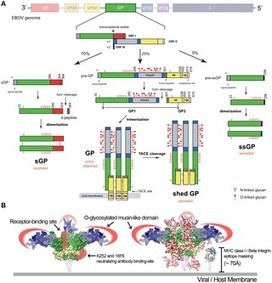Survival of infection with Ebola virus (EBOV) depends on the ability of the host to mount early and strong immune responses [1], [2]. However, given that EBOV cases are associated with 40%–90% human mortality, EBOV has developed intricate solutions to human immunological defenses. Enveloped viruses, like EBOV, must deposit their genetic material within a cell to ensure their propagation. The roles of viral envelope glycoproteins in mediating virus attachment to host cells and catalyzing the subsequent fusion of the viral and host plasma membranes have been well described (reviewed in [3]). Given the limited number of genes in EBOV and other viruses, it stands to reason that these conformationally labile glycoproteins are also involved in more than just the initial steps of a productive infection. There is strong evidence that viral entry glycoproteins (GP) are modulators of host antiviral defenses (Table 1). In this article, we discuss our current structural understanding of the functions of envelope entry glycoproteins in immune evasion using EBOV as our example.
Research and publish the best content.
Get Started for FREE
Sign up with Facebook Sign up with X
I don't have a Facebook or a X account
Already have an account: Login
Topical news snippets about viruses that affect people. And other things. Like Led Zeppelin. And zombies B-)
Curated by
Ed Rybicki
 Your new post is loading... Your new post is loading...
 Your new post is loading... Your new post is loading...
|











Nice review on a very interesting and important topic - and highlights how viral entry proteins double as immune evasion agents.